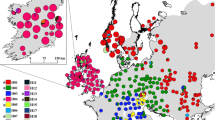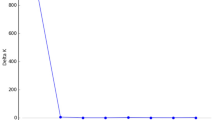Abstract
The level of genetic variation throughout the Italian range of common ash (Fraxinus excelsior L.) was estimated using six microsatellite markers. High levels of allelic diversity was detected. The levels of expected heterozygosity for each of the populations ranged from 0.726 to 0.871, with an average of 0.798, and indicated that populations have a high level of genetic variation. A general and significant homozygote excess was found at most loci in all populations, with an overall mean F IS of 0.284. Possible explanations for such situations are discussed. Only 4.9% of the total diversity was attributable to differentiation among populations. Although divergence among pedo-climatic regions explained only a small part of the variance it was possible to observe some partial clustering of populations belonging to the same regions. The contribution of the results in relation to the definition of the most appropriate strategies to collect forest reproductive material is discussed.
Résumé
Le niveau de variation génétique dans l’aire de distribution naturelle du frêne commun (Fraxinus excelsior L.) en Italie a été estimé à l’aide de six marqueurs microsatellite. Des niveaux élevés de diversité allélique ont été détectés. L’hétérozygotie théorique varie de 0,726 à 0,871, avec une moyenne de 0,798, ce qui indique que les populations ont un niveau élevé de variation génétique. Un excès général et significatif de l’homozygotie a été trouvé pour la plupart des loci dans toutes les populations, avec une moyenne globale F IS de 0,284. Des explications possibles pour de telles situations sont proposées. Seulement 4,9 % de toute la diversité est attribuable à la différenciation entre populations. Bien que la divergence entre régions pédo-climatiques explique une petite partie de la variation, il est possible d’observer des regroupements partiels de populations appartenant aux mêmes régions. La contribution de ces résultats à la définition des stratégies les plus appropriées pour rassembler le matériel forestier de reproduction est discutée.
Similar content being viewed by others
References
Bacles C.F.E., Burczyk J., Lowe A.J., Ennos R.A., Historical and contemporary mating patterns in remnant populations of the forest tree Fraxinus excelsior L., Evolution 59 (2005) 979–990.
Belletti P., Monteleone I., Frassino maggiore, in: Calvo E., Fedrigol M., Vaiani L. (Eds.), Caratterizzazione genetica di popolazioni forestali della Lombardia. Regione Lombardia, Azienda Regionale delle Foreste, Milano, 2002, pp. 44–48.
Belletti P., Monteleone I., Ferrazzini D., Genetic variability at allozyme markers, in sycamore (Acer pseudopatanus L.), populations from north-western Italy, Can. J. For. Res. (2007) (in press).
Boshier D., Amaral W., Threats to forest ecosystems and challenges for the conservation and sustainable use of forest genetic resources, in: Vinceti B., Amaral W., Meilleur B. (Eds.), Challenges in managing forest genetic resources for livelihoods, IPGRI, Rome, 2004, pp. 7–22.
Boshier D., Stewart J., How local is local? Identifying the scale of adaptative variation in ash (Fraxinus excelsior L.): results from the nursery, Forestry 78 (2005) 135–143.
Brachet S., Jubier M.F., Richard M., Jung-Muller B., Frascaria-Lacoste N., Rapid identification of microsatellite loci using 5′ anchored PCR in the common ash Fraxinus excelsior L., Mol. Ecol. 8 (1999) 160–163.
Brookfield J.F.Y., A simple new method for estimating null allele frequency from heterozygote deficiency, Mol. Ecol. 5 (1996) 453–455.
Bruford M.W., Ciofi C., Funk S.M., Characteristics of microsatellites, in: Karp A., Isaac P.G., Ingram D.S. (Eds.), Molecular Tools for Screening Biodiversity, Chapman & Hall, London, 1998, pp. 202–205.
Comes H.P., Kadereit J.W., The effect of Quaternary climatic changes on plant distribution and evolution, Trends Plant Sci. 3 (1998) 432–438.
Cundall E.P., Cahalan CM., Connolly T., Early results of ash (Fraxinus excelsior L.) provenance trials at sites in England and Wales, Forestry 76 (2003) 385–399.
Eriksson G., Global warming and gene conservation of Noble Hardwoods, in: Turok J., Jensen J., Palmberg-Lerche C., Rusanen M., Russell K., de Vries S., Lipman E. (Eds.), Noble Hardwood Network — Report of the Third Meeting, 13–16 June 1998, Sagadi, Estonia, International Plant Genetic Resources Institute, Rome, 1999, pp. 98–112.
European Commission, Georeferenced soil database of Europe, Manual of procedures, Version 1.0, EUR 18092 EN, 1999.
Excoffier L., Smouse P.E., Quattro J.M., Analysis of Molecular Variance Inferred From Metric Distances Among DNA Haplotypes: Application to Human Mitochondrial DNA Restriction Data, Genetics 131 (1992) 479–491.
Excoffier L., Laval G., Schneider S., Arlequin (version 3.0): An integrated software package for population genetics data analysis, Evol. Bioinf. Online 1 (2005) 47–50.
Farris M.A., Mitton J.B., Population density, outcrossing rate, and heterozygosity superiority in ponderosa pine, Evolution 38 (1984) 1151–1154.
Felsenstein J., PHYLIP: Phytogeny Inference Package, Version 3.6. (2004) http://evolution.genetics.washington.edu/phylip/doc/main.html.
FRAXIGEN, Ash species in Europe: biological characteristics and practical guidelines for sustainable use, Oxford Forestry Institute, University of Oxford, U.K., 2005.
Gérard P.R., Fernandez M.J.F., Frascaria-Lacoste N., Temporal cline in a hybrid zone population between Fraxinus excelsior L. and F. angustifolia Valh, Mol. Ecol. (2006) in press.
Goudet J., FSTAT (Version 1.2): a computer program to calculate F-statistics, J. Hered. 86 (1995) 485–486.
Guo S.W., Thompson E.A., Performing the exact test of Hardy-Weinberg proportion for multiple alleles, Biometrics 48 (1992) 361–372.
Herzog S., Krabel D., Preserving genetic resources: concepts and silvicoltural consequences on some European genera of Fagaceae, Forest Snow and Landscape Research 75 (2000) 205–217.
Heuertz M., Hausman J.F., Tsvetkov I., Frascaria-Lacoste N., Vekemans X., Assessment of genetic structure with and among Bulgarian populations of the common ash (Fraxinus excelsior L.), Mol. Ecol. 10 (2001) 1615–1623.
Heuertz M., Vekemans X., Hausman J.F., Palada M., Hardy O.J., Estimating seed versus pollen dispersal from spatial genetic structure in the common ash, Mol. Ecol. 12 (2003) 2483–2495.
Heuertz M., Fineschi S., Anzidei M., Pastorelli R., Salvani D., Paule L., Frascaria-Lacoste N., Hardy O.J., Vekemans X., Vendramin G.G., Chloroplast DNA variation and postglacial recolonization of common ash (Fraxinus excelsior L.) in Europe, Mol. Ecol. 13 (2004) 3437–3452.
Heuertz M., Hausman J.F., Hardy O.J., Vendramin G.G., Frascaria-Lacoste N., Vekemans X., Nuclear microsatellites reveal contrasting patterns of genetic structure between western and southeastern European populations of the common ash (Fraxinus excelsior L.), Evolution 58 (2004) 976–988.
Huntley B., Birks H.J.B., An Atlas of Past and Present Pollen Maps of Europe: 0–13 000 Years Ago, Cambridge University Press, Cambridge, 1983.
Lefort F., Brachet S., Frascaria-Lacoste N., Edwards K.J., Douglas G.C., Identification and characterization of microsatellite loci in ash (Fraxinus excelsior L.) and their conservation in the olive family (Oleaceae), Mol. Ecol. 8 (1999) 1088–1090.
Mantel N., The detection of disease clustering and a generalized regression approach, Canc. Res. 27 (1967) 209–220.
Morand M.E., Brachet S., Rossignol P., Dufour J., Frascaria-Lacoste N., A generalized heterozygote deficiency assessed with microsatellites in French common ash populations, Mol. Ecol. 11 (2002) 377–385.
Morand-Prieur M.E., Raquin C., Shykoff A., Frascaria-Lacoste N., Males outcompete hermaphrodites for seed siring success in controlled crosses in polygamous Fraxinus excelsior (Oleaceae), Am. J. Bot. 90 (2003) 949–953.
Namkoong G., Forest Genetics and Conservation in Europe, in: Turok J., Palmberg-Lerche C., Skrøppa T., Ouédraogo A.S. (Eds.), Conservation of forest genetic resources in Europe, International Plant for Genetic Resources Institute, Rome, 1998, pp. 3–10.
Nei M., Genetics distance between populations, Am. Nat. 106 (1972) 282–292.
Nei M., Molecular Evolutionary Genetics, Columbia University Press, New York, 1987.
Newton A.C., Allnutt T.R., Gillies A.C.M., Lowe A.J., Ennos R.A., Molecular phylogeography, intraspecific variation and the conservation of tree species, Trends Ecol. Evol. 14 (1999) 140–145.
Palmberg-Lerche C., Conservation of forest biological diversity and forest genetic resources, in: Palmberg-Lerche P., Iversen P.A., Sigaud P. (Eds.), Forest Genetic Resources 29, Food and Agriculture Organization of the United Nations, Rome, 2001, 70 p.
Pemberton J.M., Slate J., Bancroft D.R., Barrett J.A., Nonamplifying alleles at microsatellites loci: a caution for parentage and population studies, Mol. Ecol. 4 (1995) 249–252.
Picard J.F., Contribution a l’étude de la biologie florale et de la fructification du Frêne commun (Fraxinus excelsior L.), Rev. For. Fr. 34 (1982) 97–107.
Pliûra A., European long-term gene conservation strategies: Ash (Fraxinus spp.), in: Turok J., Jensen J., Palmeberg-Lerche C., Rusanen M., Russell K., de Vries S., Lipman E. (Eds.), Noble hard-woods network — Report of the third meeting, 13–16 June 1998, Sagadi, Estonia, International Plant Genetic Resources Institute, Rome, 1999, pp. 8–20.
Raymond M., Rousset F., Genepop (version 1.2): population genetics software for exact tests and ecumenicism, J. Hered. 86 (1995) 248–249.
Reynolds J., Weir B.S., Cockerham C.C., Estimation for the coancestry coefficient: basis for a short-term genetic distance, Genetics 105 (1983) 767–779.
Rholf F.J., NTSYS-PC, Numerical taxonomy and multivariate analysis system, Version 2.1, Setauket, NY, USA, Exeter Publishing, 2000.
Rice W.R., Analyzing tables of statistical tests, Evolution 43 (1989) 223–225.
Rossi P., Vendramin G.G., Giannini R., Estimation of mating system parameters in two Italian natural populations of Fagus sylvatica, Can. J. For. Res. 26 (1996) 1187–1192.
Slatkin M., A measure of population subdivision based on microsatellite allele frequencies, Genetics 139 (1995) 457–462.
SPSS, SPSS Base 12.0 for Windows User’s Guide, SPSS Inc., Chicago, IL, 2003.
Tessier du Cros E., Màtyàs C., Kriebel H., Contribution of genetics to the sustained management of global forest resources — Conclusions and recommendations, in: Màtyàs C. (Ed.), Forest genetics and sustainability, Forestry Sciences, Vol. 63, Kluwer Academic Publishers, Dordrecht, 1999, pp. 281–287.
Toro M.A., Caballero A., Characterization and conservation of genetic diversity in subdivided populations, Phil. T. Roy. Soc. B. 1459 (2005) 1367–1378.
Van Oosterhout C., Hutchinson W.F., Wills D.P.M., Shipley P., Micro-checker: software for identifying and correcting genotyping errors in microsatellite data, Mol. Ecol. Notes 40 (2004) 535–538.
Vendramin G.G., Degen B., Petit R., Anzidei M., Madaghiele A., Ziegenhagen B., High level of variation at Abies alba chloroplast microsatellite loci in Europe, Mol. Ecol. 8 (1999) 1117–1126.
Weir B.S., Cockerham C.C., Estimating F-statistics for the analysis of populations structure, Evolution 38 (1984) 1358–1370.
Wright S., Systems of mating, Genetics 6 (1921) 111–178.
Wright S., Evolution and the genetics of populations, The theory of gene frequency, Vol. 2, University of Chicago Press, Chicago, IL, 1969.
Yadzani R., Muona O., Rudin D., Szmidt A.E., Genetic structure of a Pinus sylvestris L. seed-tree stand and naturally regenerated understory, For. Sci. 31 (1986) 430–436.
Author information
Authors and Affiliations
Corresponding author
Rights and permissions
About this article
Cite this article
Ferrazzini, D., Monteleone, I. & Belletti, P. Genetic variability and divergence among Italian populations of common ash (Fraxinus excelsior L.). Ann. For. Sci. 64, 159–168 (2007). https://doi.org/10.1051/forest:2006100
Received:
Accepted:
Issue Date:
DOI: https://doi.org/10.1051/forest:2006100




